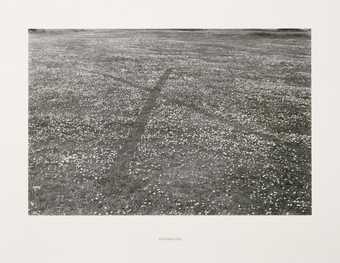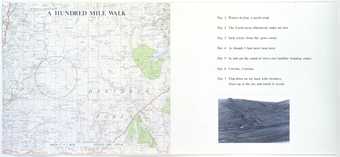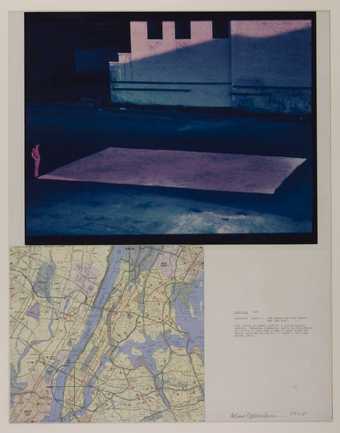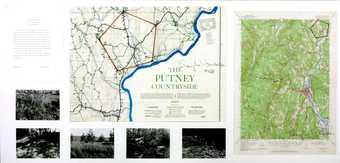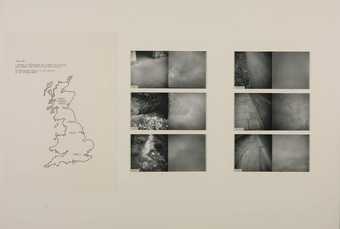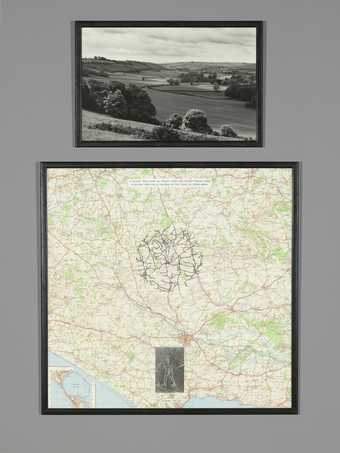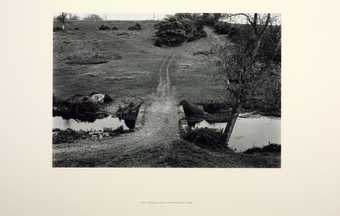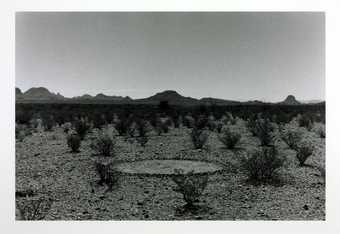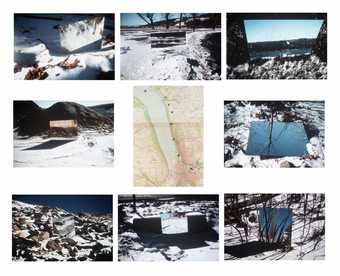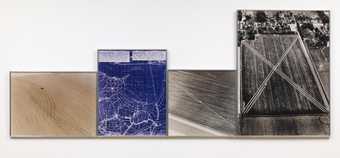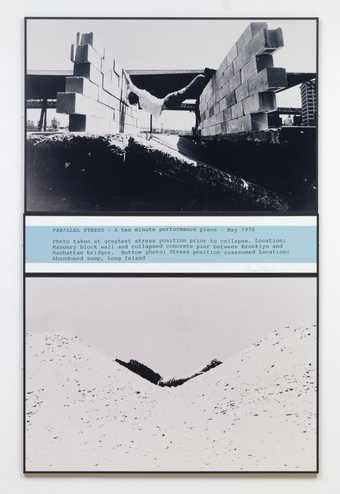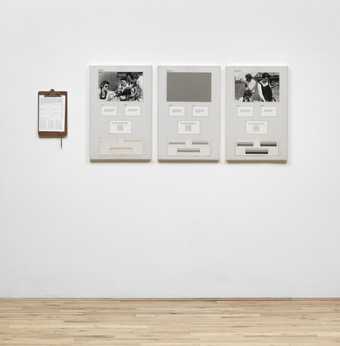
Not on display
- Artist
- Dennis Oppenheim 1938–2011
- Medium
- 4 works on paper, photographs, map and typescript, mounted on board
- Dimensions
- Support: 710 × 560 mm
frame: 720 × 568 × 34 mm - Collection
- Tate
- Acquisition
- Presented by the American Fund for the Tate Gallery, courtesy of an anonymous donor 2000
- Reference
- T07590
Summary
Directed Harvest is the documentation of an action that Oppenheim undertook in a Pennsylvania wheat field. A small section of typed text on the collage describes the action: ‘Massey Harris harvester directed by artist to break down surface in linear patterns, following ¼, ½, ¾ and full eradication. Trucking and processing is included in later stages of sculpture. Land owner: Lester A. Adam’. The text is headed by the title: ‘100’ X 1000’ Pennsylvania wheat field’ and a hand-written notation under the landowner’s name, ‘Hamburg, Penn.’. This text appears next to a colour photograph of a rural scene, with a partially harvested wheatfield in the foreground. Above the photograph and section of text, a black and white aerial view shows the patterning of fields when seen from far above. A circle and the word ‘location’ identify the field in which Oppenheim’s action took place as a black shape adjacent to a road. Next to this view, a section of map, also with a circle and the word ‘location’ plus a vertical line, show the position of the field according to traditional cartography. Below the aerial view and the map, and above the section of type-written text, the words: ‘DETAIL. DIRECTED HARVEST.WHEAT’ have been applied to the board. The board is signed with the inscription ‘June 1966’.
Directed Harvest is one of several works Oppenheim made between 1966 and 1970 that involved physical intervention on the land. These outdoor artistic interventions or ‘earthworks’ by Oppenheim and such American artists Robert Smithson (1938–73), Walter de Maria (born 1935) and Michael Heizer (born 1944) were part of a movement, termed ‘Earth Art’ in the US and ‘Land Art’ in England, arising in the late 1960s as a development from Minimalism, one of the dominant movements in American art of the early 1960s. In Earth Art the focus was removed from an object specifically created for a gallery or museum space. Instead the artist interacted directly with the landscape, resulting in ambiguities about the formal boundaries of the art work. For Oppenheim, the focus was on action, emphasising process and change. Many of his early interventions into the natural landscape took the form of excavating and removing, returning to the tradition of making sculpture ‘by taking away rather than adding’ (Oppenheim quoted in Norvell, p.22) as in the ancient practice of carving. At the time, this contrasted strongly with the Minimalist processes of semi-industrial construction and the more expressive creation of assemblages that had developed from Abstract Expressionism at the end of the 1950s. Replacing the painter’s canvas with the landscape and the artist’s expressive hand with non-expressive, directed machinery and farm labourers opened new territories for art. In Directed Harvest the landscape is altered by the action of harvester progressively cutting and removing the ripe wheat, enacting a form of progressive, impermanent carving on the land.
Unlike the works of de Maria and Heizer, which are permanent installations in the landscape or or moveable installations in the gallery, Oppenheim’s Earth Art projects, like Directed Harvest and a similar work Directed Seeding – Cancelled Crop 1969 (see Tate T12402), were ephemeral, only surviving through photographic documentation. These particular works combine the natural cycles of the seasons and plant growth with the processes of industrial farming (ploughing, seeding and harvesting). In another work from the same period, Salt Flat, 1968 (Tate T01773), Oppenheim laid a rectangular pile of 1,000 pounds of crystalline salt in a New York parking lot and left it to be carried away by the wind. The work was intended to include the same quantity of salt being laid on the ocean bed, where it would dissolve, and on the surface of the Salt Lake desert in Utah, where it would be incorporated into the land, thus emphasising natural forces as the agents of change. At the time of making these works, Oppenheim was more interested in the ephemeral action than in creating an object-based residue which, many years later, is the only remaining form of the work. In 1969 he commented:
The aspect of the documentation that I would tend to reject is that it’s taking us back into an object, or into a rigid static kind of form which is exactly what the new work doesn’t imply. A good part of the processing pieces that I’ve done are pieces that involve following the processes of [how] a particular med[ium] move[s] in time and place. And to solidify this through a photographic abstraction is ripping a thing that’s going with a certain force out and throwing it back to the dormancy of a rigid form of communication … It’s a problem.
(Quoted in Norvell, p.23.)
In Directed Harvest, the action of the artist, in directing the way in which the harvest is undertaken, is analogous to a painter who applies fields of colour onto a canvas or who draws lines onto paper. The viewer of Oppenheim’s documentation must visualise in his or her own mind the patterning on the Pennsylvania landscape created by the Massy Harris harvester in autumn 1966 and the subsequent processing of the wheat.
Further reading:
Alanna Heiss and Thomas McEvilley, Dennis Oppenheim: Selected Works 1967–1990, exhibition catalogue, Institute for Contemporary Art, PS1, New York 1992.
Germano Celant, Dennis Oppenheim: Explorations, Milan 2001, p.51.
Patricia Norvell, Recording Conceptual Art, Berkeley, Los Angeles, London 2001.
Elizabeth Manchester
March 2007
Does this text contain inaccurate information or language that you feel we should improve or change? We would like to hear from you.
Display caption
Directed Harvest took place in a Pennsylvania wheat field. Oppenheim altered the landscape by directing a harvester to cut the ripe wheat into ‘linear patterns’, ending in ‘full eradication’, or a complete harvest of the crop. This impermanent carving into the land could be related to traditional sculpture, but in contrast, viewers need to visualise the reshaping of the landscape created by the harvester. Oppenheim was interested in ‘following the processes’ in his ephemeral work and was wary of ‘solidifying’ it through photographic documentation.
Gallery label, February 2016
Does this text contain inaccurate information or language that you feel we should improve or change? We would like to hear from you.
Explore
- emotions, concepts and ideas(16,416)
-
- formal qualities(12,454)
-
- aerial view(121)
- photographic(4,673)
- scientific and measuring(791)
-
- map(110)
- countries and continents(17,390)
- inscriptions(6,664)
-
- instructions(36)
- printed text(1,138)
You might like
-
Richard Long CBE A Line Made by Walking
1967 -
Richard Long CBE A Line Made by Walking
1967 -
Richard Long CBE England 1968
1968 -
Douglas Huebler Variable Piece No. 44
1971 -
Richard Long CBE A Hundred Mile Walk
1971–2 -
Dennis Oppenheim Salt Flat
1968 -
Douglas Huebler Site Sculpture Project, Windham College Pentagon, Putney, Vermont
1968 -
Richard Long CBE Untitled
1967 -
Richard Long CBE Cerne Abbas Walk
1975 -
Richard Long CBE Silence Circle Big Bend Texas
1990 -
Robert Smithson Ithaca Mirror Trail, Ithaca, New York
1969 -
Dennis Oppenheim Directed Seeding - Cancelled Crop
1969 -
Dennis Oppenheim Parallel Stress
1970 -
Stephen Willats ‘The Lunch Triangle’: Pilot work B. Codes and Parameters
1974



